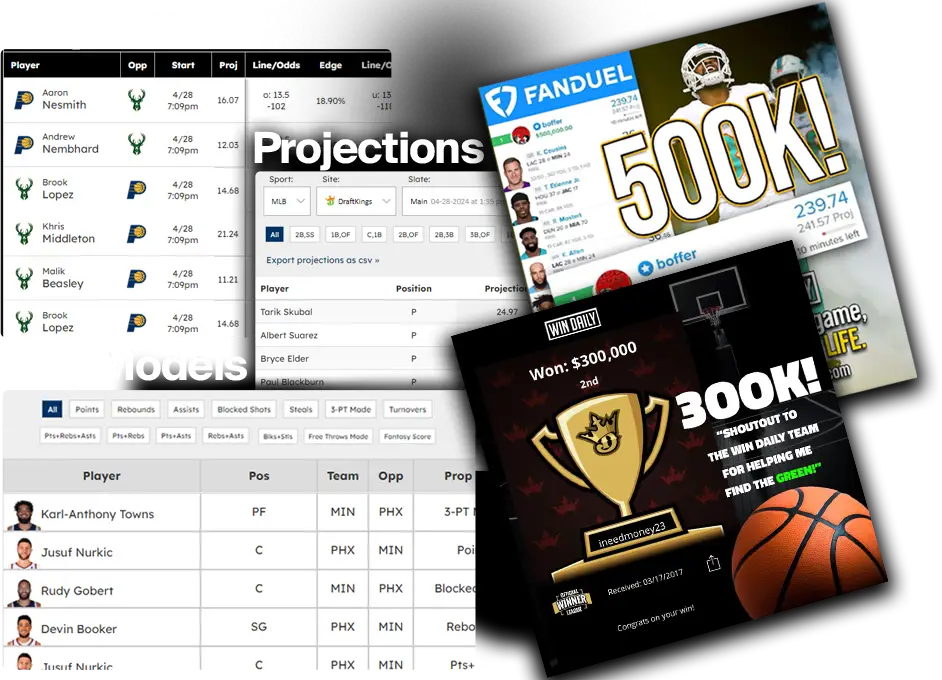This article breaks down the rules I “generally use” in the Win Daily Optimizer to MME (mass-multi-enter) on DraftKings and FanDuel NFL showdown slates. I use the term “generally” because this is a starting point for a top-down look at how I approach each slate. When analyzing salaries and team schemes it might make sense to remove or add a rule in the optimizer from time to time, but that will be addressed in the specific showdown breakdown articles. Make it a point to check out the key rules for each specific slate, however, keep this article as a reference.
Simply having access to an optimizer is not a guarantee to making big bucks. You also have to know how to use it, which is what I dive into below.
General Rules I use for Showdown
1. In large field GPP’s never use your entire salary, if you plan on maxing out 150 lineups. If you win it will be a major letdown because the prize pool will be huge split at the top.
This is not to say a lineup using the entire salary can’t win, it can and it does. However, when it does a 100K top prize gets split up 1,000 ways netting you a few hundred bucks if you are lucky as opposed to a big payday when you differentiate simply by adding salary perimeters. Novice players almost always FOMO themselves into using their entire salary, resulting in massive duplications. I will play every Showdown slate this season, and I will never use the entire salary on one lineup. That’s a guarantee.
2. Maximize lineups with your core players, mixing in low-rostered players.
If you are maxing 150 don’t adjust projections and take the best 150 lineups the optimizer spits out. Pick the guys you like, build rules locking in your favorites, and then run the Opto to see how many combinations you get with those Core players. If my player rules only make 100 lineups (out of 150), I love it. This means I have every combination of every guy that I like. The next 50 lineups I make, if I choose to do so, I can take bigger swings. For example, I can filter out one of my Core players or filter in one total punt guy.
*It is important to note that you will be making multiple spreadsheets to export in this example. It is not just one that you simply upload. Yes, it takes some work but it will pay off.
Here is an experiment you can run. Once you build your rules, set the opto to 300 lineups. If you get 300, meaning you get well over the 150 max, you have more work to do. Keep shaving it down, by adding rules or other parameters (salary, ownership, etc.), to get it below 150. You cannot be mad at yourself if you don’t win when you know you played the guys you love, and they just don’t hit. When you will be mad is when you go back and see your 200th-best lineup was the nuts and it was all guys you liked.
I have found that most of, if not all of, my big wins come from when I maximize my core, mixing in low-rostered plays.
3. DraftKings is more fun. FanDuel is easier to win. Which one matters most to you?
If you are trying to profit consistently, FanDuel is a much easier site for MMEing showdowns. You are only able to pick 5 guys as opposed to 6 on DraftKings, which limits the combinations you can make (which is what you want). The MVP prices don’t change when they are moved from the flex, limiting the combinations you can make compared to DraftKings. There are also price floors on FanDuel of $5,000 as opposed to $100 on DraftKings, which again limits the combinations therefore increasing your chances of winning due to minimizing the number of combinations that can be produced.
4. Have a method for your salary parameters (this tends to matter more on FanDuel)
It’s a broken record here, but this also helps limit combinations. This is how I do it (and I doubt anyone else does). I want to look over the prices and determine where the gap is for a player who could not possibly outscore a higher-priced stud player.
For this example, let’s say I am on FanDuel and Travis Kelce is $10,000 while Skyy Moore is $5,000. I do not see a scenario where both play a full game and Moore scores more than Kelce, so I am going to limit my range of outcomes to a salary that would never allow Moore over Kelce.
In this example, I am subtracting $5,000 (Moore’s salary) from $10,000 (Kelce’s salary). I get $5,000. So, my salary range becomes $49,999 (because I am never playing full salary) to $45,000. I am then going to add a dollar to the $45,000 making it $45,001. This will not allow combinations on the opto with Skyy Moore when Travis Kelce would have fit in that same lineup.
This can be a much larger gap on DraftKings due to price floors dropping lower. There are also cases where I have seen leaving over $10,000 on the table win by just stacking defenses and kickers plus skill players (not quarterbacks) in one-off scenarios. For example, when the Denver Broncos played the Indianapolis Colts on primetime two seasons ago, neither team scored a touchdown. In these game-specific examples, salary parameters don’t matter, but these are few and far between and I don’t recommend chasing them.
Other General Rules for Showdown (unless otherwise stated in the MNF, TNF, or SNF game breakdowns)
Don’t use an RB and his backup in the same lineup, in most cases.
- There are team schemes where this could work such as Raheem Mostert with De’Von Achane, but it is still unlikely (not impossible) that they both do enough to make the optimal, given there are no egregious pricing errors. Most of the time when there are two solid options both RBs are priced up making it even more difficult for both guys, who play the same position, to pay off. Pick only one unless I specifically say not to in the game breakdowns.
Don’t use a WR and his depth chart “backup” in the same lineup.
- It is unlikely they both make the optimal lineup
- Can it happen where both make the optimal? Yes, it can. Does it happen often? No, it does not. Stick to this method each week and it will pay off over the season.
Don’t use a TE and his backup in the same lineup
- I encourage taking stabs on TE2 or TE3 but almost never with the starter in the same lineup. There are only so many TE touchdowns to go around. When you will really benefit is when the TE1 leaves the game early then you have his backup at 2% owned.
Don’t use more than one low-usage player in a lineup.
- These are typically bench players.
- This means making a group of all low-usage players, from both teams, and allowing a max of one. This includes QB, WR, RB, and TE. You only have so many positions to fill and taking a combo of guys, who might not see more than a snap or two isn’t the way to win in Showdowns. You just need one low-owned guy to separate you from the field.
In most cases, I fade two quarterbacks in the same lineup on FanDuel, not on DraftKings.
- This happens naturally. If I have a QB, who is more of a passer than a runner, I want 2 pass catchers from him. There are only 5 spots to fill on FanDuel so that means 2 QBs and 2 pass catchers from each are not going to fit (like it can on DraftKings)
- If you have 2 QBs who can run, like Lamar Jackson and Jalen Hurts, I back off this rule somewhat. If this is Jared Goff and Baker Mayfield I lean into it more.
- On DraftKings you see double QB pairings pay off a decent number of the time so there is no reason to limit them on that particular site.
Don’t play more than two pass catchers from a team without rostering their QB.
- If two WRs, TEs, or strictly pass catching RBs exceed value, their QB is having a good game as well
Always pair a QB with two pass catchers from the same team
- This does not apply to QBs who are known to score on the ground like Josh Allen and Lamar Jackson and whoever else may emerge this season
- I still want to pair them with at least 1 pass catcher (WR, TE, RB) regardless of the upside they bring with their legs.
Never play a QB naked.
- Could Lamar Jackson score every touchdown by himself? I suppose he could in a perfect scenario, but it is much more likely he does not. If you start playing QBs naked after seeing him win a GPP once alone, you could get into a vicious cycle of trying to chase the improbable resulting in losing your bankroll fast.
Do not use more than half of your roster against your defense.
Do not use the opposing defense against your QB CPT/MVP in your lineup
- If Patrick Mahomes is the highest-salary player, and pays off enough to be the optimal CPT, it is very unlikely the opposing defense had a night worth rostering
If you play a WR or TE in the CPT or MVP/CPT spot, you have to roster their QB in the flex.
- If the WR or TE goes off, their QB did enough to make the optimal
Don’t play backup QB’s if they are not named as the starter
Don’t neglect your kickers
- They are some of the most reliable options to consistently put up fantasy points. Of course, you need to take into account extreme matchups and severe weather games, but this does not happen often.
Having one “punt” player is usually enough.
- You don’t need to worry about choosing all low-owned guys
Pair your kicker with at least one RB, WR, or TE
- Someone has to move the ball down the field to get the kicker in range.
Kickers and Defenses do not make for a reliable CPT/MVP option
- Skip them and use quarterbacks and skill players
If you are new to MMEing showdown slates this might seem like a lot to digest. The truth is winning money playing DFS and it is a lot of work. If you are trying to just get lucky without putting in the effort, you are likely not going to be profitable. The rules I have listed above should be considered very highly when you are building. Set aside some time before the slate knowing you have work to do.






